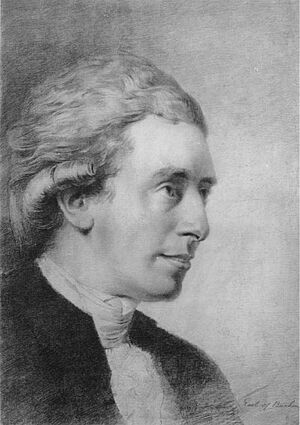David Erskine, 11th Earl of Buchan facts for kids
David Steuart Erskine, 11th Earl of Buchan (born June 1, 1742, died April 19, 1829) was a Scottish nobleman. He was known for his love of old things and history, called an antiquarian. He started the Society of Antiquaries of Scotland in 1780. He also supported artists and scientists. From 1747 to 1767, he was known as Lord Cardross.
Contents
Early Life and Learning
David Steuart Erskine was the second son of Henry Erskine, 10th Earl of Buchan. His mother was Agnes Steuart. He had two famous brothers, Henry Erskine and Lord Erskine. His sister, Lady Anne Agnes Erskine, was involved with a religious group.
David went to several universities:
- St. Andrews University (1755–1759)
- Edinburgh University (1760–1762)
- Glasgow University (1762–1763)
He learned from important thinkers like Adam Smith and Joseph Black. In 1771, he married Margaret Fraser. They did not have any children.
His main home was Kirkhill House in Broxburn, West Lothian. He inherited this old house, built in 1590. He had it greatly changed and improved in 1770 and 1771.
His Work and Interests
David Steuart Erskine was very active in public life. He helped change how Scottish nobles were chosen to represent Scotland in the House of Lords in London. This was a big deal for Scottish politics.
He was offered a job at the British Embassy in Madrid in 1766. But he turned it down because his father was very ill. His father passed away in 1767. He was also the Grand Master of Scottish Freemasons from 1782 to 1784.
Friends with Famous Americans
The Earl of Buchan was friends with Benjamin Franklin, a famous American inventor and politician. They met in Scotland and London. He also supported the American cause for independence.
He wrote letters to George Washington, who became the first President of the United States. He sent Washington a special gift: a box made from an oak tree. This tree was said to have hidden William Wallace, a Scottish hero, after the Battle of Falkirk. The Earl asked Washington to pass the box to the most deserving person in America after his death. Washington thanked him but felt he could not choose. So, in his will, Washington returned the box to the Earl.
Founding the Society of Antiquaries
In 1780, he started the Society of Antiquaries of Scotland. He wanted a group to study old things and history in Scotland. This society was officially formed on December 18, 1780. He was the first vice president. However, he later disagreed with some of the society's ideas and left in 1790.
Even after leaving the main society, he kept studying history. He wrote many papers and joined the Literary and Antiquarian Society of Perth in 1785. He was also chosen as a member of the American Philosophical Society in 1794. In 1816, he became a member of the American Antiquarian Society. He was also honored by academies in Denmark and Iceland.
Dryburgh Abbey and Monuments
Later in life, he spent a lot of time at Dryburgh House. He decorated the grounds with monuments. These included statues and memorials to his ancestors. He also honored famous Scots like the poet Robert Burns and the hero William Wallace.
He also ordered a special bridge to be built over the River Tweed at Dryburgh. This was a cable-stayed bridge, a new type of bridge at the time. He opened this bridge on August 1, 1817. But it fell down within months. A new design was built, but it also collapsed in 1838. A strong, lasting bridge was finally built in 1872, using a different design called a suspension bridge.
Later Years and Personality
In his later years, the Earl became known for being a bit unusual. This sometimes made people overlook his many talents. The famous writer Walter Scott noted this. After the Earl died, he was buried at Dryburgh. Sir Walter Scott joked that his head was laid the wrong way, saying it "had never been quite right in his lifetime."
The Earl wrote many letters to other important people, including Horace Walpole. He also wrote books, like an Essay on the Lives of Fletcher of Saltoun and the Poet Thomson (1792).
There is a fun story about the Earl meeting the writer Charles Lamb. The poet George Dyer brought the Earl to Lamb's home. Charles Lamb was not there, and his sister Mary Lamb was very surprised to have an Earl visit without warning!
Death
David Steuart Erskine died at his home in Dryburgh in April 1829. He did not have any children who could legally inherit his title. So, his nephew Henry became the 12th Earl of Buchan. However, the Earl's other properties, including Dryburgh, went to his son, Sir David Erskine.


